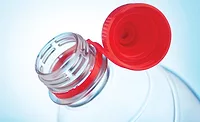Next Generation Caps & Closures
Next Generation Caps & Closures
By JOANNA COSGROVE
Beverage manufacturers look for functionality and
greater shelf appeal
A new breed of
beverage caps is hitting the market and they fall outside the realm of
traditional twist-off closures. Not only do they preserve freshness and
prevent spilling, but some offer a distinctive point of difference with
unique functionality, while others are a twist on the usual that
differentiate the total beverage package on shelf.
Dubbed a “Seriously Twisted Technology,”
the Infusion Cap from U.S. Beverage, Newnan, Ga., features a reservoir that
can be filled with any liquid or powder. When the cap is twisted, the
contents are released into the bottled beverage below the cap. The cap has
been in the R&D pipeline for three years and holds a variety of
patents. U.S. Beverage’s Rob Hobson, vice president, said it was
originally developed to help the company demo a line of kids drinks called
Seriously Twisted, with the idea that kids would embrace the line’s
interactive packaging.
The caps are engineered to hold 3 ml. to 7 ml. of
liquid or powder and can fit nearly all existing water bottles. And because
the concentrate is separate from the beverage until time of consumption,
the cap allows for a shelf life of 12 to 18 months.
Hobson says U.S Beverage can contract fill the caps and pack the finished product or supply the
filled caps to bottlers. “One segment that we saw the biggest
interest was in the bottled water industry,” Hobson says.
“Bottlers that want to add flavors, minerals and vitamins to their
line but don’t want to invest millions in the equipment.”
Design accent
Caps can provide the crowning touch to a package
design. Jolt Cola was re-launched by its parent company Wet Planet this
past February in a resealable 23.5 ounce aluminum Battery Bottle shaped
container.
The new Jolt bottle, manufactured by Rexam Beverage
Can North America, features a power gauge printed in thermo- chromic ink
that changes colors when the beverage is chilled. As the beverage is
consumed, the ink returns to its original color showing the consumer how
much liquid is left. The resealable twist-off cap stylishly preserves
product freshness.
The Jolt Battery Bottle combines Rexam’s Monster
can body with Cap Can closure technology. The can is transformed into a
re-sealable container by seaming on a Cap Can end and closure, a patented
process developed by Dayton Systems Group Inc. (DSG), Miamisburg,
Ohio. Once complete, the Jolt Battery Bottles are shipped to Pri-Pak, an
independent beverage co-packer located in Lawrenceburg, Ind., where they
are filled with the Jolt product. Rexam worked in partnership with Pri-Pak
to develop a unique and flexible filling process for the package.
Another new closure, the Regal from Owens-Illinois,
Toledo, Ohio, recalls the traditional image of a soft drink package by
capturing the appearance of the original metal crown closures on glass
bottles. The closure is currently topping off 250-ml. PET carbonated soft
drink bottles in select European markets.
“The technology behind the Regal closure is that
it’s a one-piece system and it features the O-I Outside Deformable
Seal (ODS) closure,” says Steve Carter, an O-I sales director based
in Europe.
The Regal closure with the ODS feature is capable of
carbon dioxide retention of up to 4.7 gas volumes. It’s designed to
perform in high temperatures and preserve the original taste of the
product. An oxygen barrier liner also can be applied for beer applications.
The closure can be customized for other beverage
applications, including pressurized water, low carbonation and high
carbonation drinks.
Cork departures?
Wines are traditionally sealed with natural cork
plugs, but a growing number of vineyards are opting for less traditional
methods to seal their prized vintages. In January, Wildhurst Vineyards
announced plans to implement aluminum screw-caps in place of natural corks
for all 20,500 cases of its Wildhurst 2004 Sauvignon Blanc.
Dennis Canning, chief executive officer at Briarcliff
Wine Co., said: “Like all of us in the wine trade, we are
particularly sensitive to the problem of ‘corked’ wines, and
this wine, especially, was meant to be consumed within a year or two of
purchase. We believe this closure does a better job in preserving the
aromatics, freshness and fruit characteristics of our Wildhurst wines. In
addition, there are considerable savings involved with this type of closure
and we can pass these savings on to the consumer. Like others, I believe
this type of closure is the future for delicate wines.”
Another emerging cork alternative is the glass cork.
In January, Alcoa Closure Systems International, Chicago, began commercial
production of VinTegra, a 100 percent inert glass closure system that looks
like a decorative decanter stopper. Made with flexible O-rings, the stopper
provides a sterile seal, preventing contamination or oxidation. An aluminum
over-cap and traditional neck sleeve ensure mechanical protection and
tamper evidence of products.This system, already in commercial
production in Europe under the trade name Vino-Lok, is available in tinted
glass and acrylic colors to match standard U.S. bottle colors.
“The VinTegra closure system fills an urgent
need in the wine industry, which has sought an alternative to natural cork
that meets both the quality and aesthetic demands of connoisseurs,”
commented Tony Smith, marketing director at Alcoa CSI North America.
“The VinTegra system has successfully completed exhaustive testing by
some of the most respected independent wine technical institutions in the
world.”
And finally, California’s Three Thieves Bandit
brand skipped the bottle and cork package altogether for its Cabernet,
opting instead for a Tetra Brik Aseptic Package and a Tetra Pak SlimCap.
This SlimCap technology is comprised of a plastic screw-cap, ring-pull and
a standard pull-tab. According to Tetra Pak, the SlimCap provides practical
storage and stacking, easy opening with tight re-closing to protect the
product, and pouring control. The package is also air-tight until opened, a
feature that standard corks and bottles can not achieve. BI
New look for Redhook
Seattle-based Redhook Ale
Brewery introduced a new line of packaging
graphics and a custom longneck bottle. The bottles feature four raised
Redhook logos, while a raised decorative band of barley circles the body,
dividing the label and literally giving the drinker something to hold onto.
The bottom label utilizes bold graphics while the top label prominently
features an evolved Redhook logo and subtle “beer drinker
verbs” such as tilt, tip and quench.
A cool sixty
Palm Bay Imports, Boca
Raton, Fla., and Antonio Soares Franco of Portugal have created a new look
for Lancers in celebration of its 60th anniversary. Lancers’ iconic
painted crock bottle has been replaced by a contemporary, sleek, frosted
bottle that highlights the color of Lancers Rosé and Lancers White.
The addition of a twist-off cap closure enhances the wines’ youthful
appeal.
Block-of-art
From the same family that produces Kendall-Jackson wines, Wine Block
Wines, Santa Rosa, Calif., offers Cabernet Sauvignon, Merlot and Chardonnay
boxed wine in an aesthetically appealing design targeted at women. Wine
Block wine is packaged in specially designed wine bags that prevent oxygen
transfer, not only reducing wine spoilage but increasing the wine’s
shelf life after opening. The 1.5 liter box retails for $9.99.
Award-winning Apple
Bacardi Big Apple was
awarded the Excellence Award by “Package
Printing Magazine.” The award, selected from more than 600 entries
across all industries and categories is for Best in Show in all categories.
The Excellence Award is an overall award based on design, appearance,
technical development, implementation, production design, difficulty to
print and printing processes. In the same competition, Bacardi
Vaníla captured second place for the
screen-printing techniques used to implement the label.
Looking for a reprint of this article?
From high-res PDFs to custom plaques, order your copy today!







